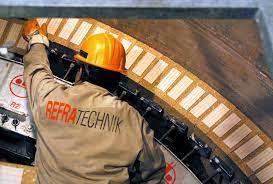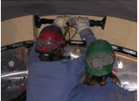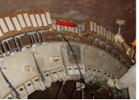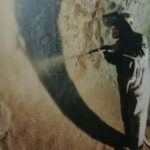WoR Rotary Kiln Refractory Brick Installation Keying Jack
Refractory Brick Installation
 A rotary kiln is lined with refractory bricks designed to withstand the tremendous heat that is generated inside the kilnshell, and the mechanical stresses that are present during the countless rotations of the shell.
A rotary kiln is lined with refractory bricks designed to withstand the tremendous heat that is generated inside the kilnshell, and the mechanical stresses that are present during the countless rotations of the shell.
Bricks can be made from a variety of materials, and are chosen for their ability to protect the shell, for their durability, and their ability to maintain the heat necessary for the process which goes on inside the kiln.
The lining bricks are wedge-shaped or tapered, designed to fit the curvature of the shell. If you look inside a kiln shell you will see thousands of bricks, laid up in rows around the circumference of the shell.
There are several methods of installation, including the screw-jack method and laying the bricks with mortar. The method chosen should suit the type and size of kiln being used, and of course, should follow the recommendations of the refractory specialist.
Refractory Brick Keying Jack
 We should look at what happens to brick linings over a period of time and why linings fail. The bricks offer many clues that can help identify the probable causes for refractory failure and may help you determine a plan of action.
We should look at what happens to brick linings over a period of time and why linings fail. The bricks offer many clues that can help identify the probable causes for refractory failure and may help you determine a plan of action.
The refractory brick keying jack is the most critical piece of equipment used in the tightening of each radial row of brick, to increase the brick lifespan.
The jacking process must take place with each row prior to keying the row in place. When using on bricking machine, the keying operation takes place every 15 minutes.
The individual rows of bricks can be laid faster and easier. With the pivoting footrests that adjust to the laying angle and bricks, damage to the bricks is less likely.
The WoR Brick Keying Jack comes with,
- Finger tip control
- Swivel foot
- Pneumatic system
- Extension kit
Maintenance


- For any pneumatic tool, keep the air hose capped to prevent dirt from entering the system.
- Thread all components tightly.
- Check fittings and replace if cracked.
- It is critical to stock a complete spare unit since the keying process relies on it.
- It is important to keep the hydraulic fluid full at all times.
- To fill the pump with fluid, unthread the end cap at the rear of the pump and fill with hrdraulic fluid.
- Keep the swivel foot tightly threaded since they are tapered pipe threads or damage will occur.
- Replace the swivel foot if they are damaged, otherwise they may fracture and cause injury.
- Keep the extension tightly threaded since they are tapered pipe threads or damage may occur.
- Replace the extension if damaged.
- If cylinder slows, check the pump for the proper fluid level.


